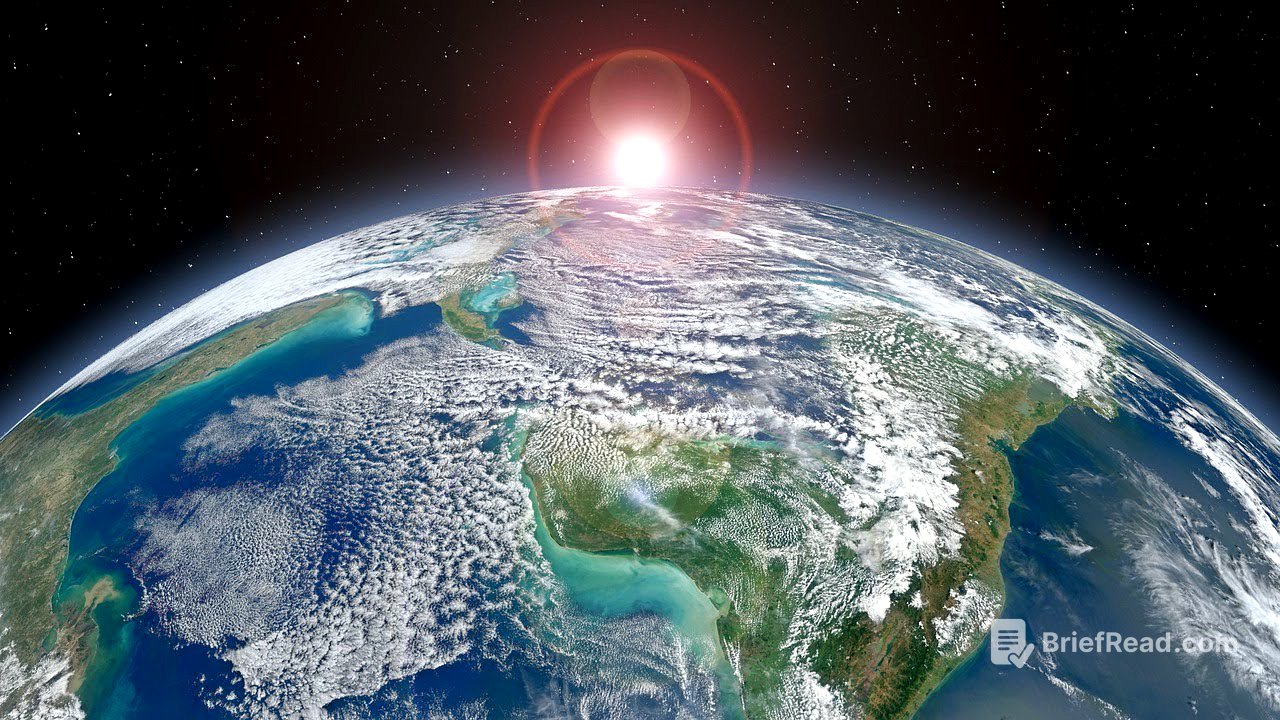TLDR;
This video explores the history of Earth, from its formation to its eventual demise, focusing on the co-evolution of the planet and its inhabitants. It highlights key events such as the formation of the moon, the emergence of life in geysers, the role of plate tectonics, the impact of cosmic events, and the evolution of life from prokaryotes to eukaryotes and eventually to humans. The video also discusses the future of Earth, including the formation of a supercontinent, the depletion of resources, and the eventual extinction of all life on the planet.
- Earth's history is marked by constant change and upheaval, driven by both internal and external forces.
- Life on Earth has repeatedly faced mass extinction events, but has always found a way to adapt and evolve.
- The evolution of life is inextricably linked to environmental changes, with each shaping the other.
- Human civilization is a relatively recent phenomenon in Earth's history, and its future is uncertain.
- The ultimate fate of Earth is to be swallowed by the sun, but life may continue in other forms and in other galaxies.
Early Earth Formation and the Emergence of Life [0:16]
The video begins by describing the early formation of the solar system, where a collision between the Milky Way and a dwarf galaxy accelerated star formation. Material circulation within the solar system led to the zonal distribution of particles based on water content. High particle density regions formed around the sun, leading to frequent collisions and the gradual growth of planetesimals. These planetesimals collided further, eventually forming planets like Earth.
The Formation of the Moon and Early Earth Environment [2:01]
The early Earth experienced collisions with other planets, including a Mars-sized planet, which resulted in the formation of the moon from the debris. Countless planetesimals and icy planets bombarded the early Earth, leading to the formation of oceans and an atmosphere. The atmosphere was initially rich in carbon dioxide, which eventually combined with rock components and was transported to the ocean floor. The early ocean was toxic, with high salinity and an overabundance of metals, making it uninhabitable for life.
Plate Tectonics and the Habitable Ocean [4:44]
Upwelling mantle displaced oceanic plates, leading to plate tectonics. Weathered sediments neutralized the acidic ocean, and heavy metals settled out as deposits at mid-ocean ridges. These deposits were transported into the deep mantle through plate tectonics. Gradually, the ocean became a habitable environment. A liquid core formed in the Earth's center, creating a strong magnetic field that shielded the surface from cosmic rays, making the Earth's surface nearing readiness for life.
Life's Origins in a Nuclear Geyser [6:58]
Primitive life emerged underground in the cave of a geyser, where uranium ore emitted radiation, creating a diverse range of materials and the building blocks of life. The geyser's water temperature remained below 100 degrees, protecting the newly formed biomolecules. The underground environment was reductive, while the surface environment was oxidizing, conditions necessary for synthesizing biomolecules. Tidal forces created wet and dry cycles, crucial for producing life's building blocks.
From Proto-Life to Prokaryotes [8:58]
Fatty acids encased proto-life molecules, and polymerization progressed under wet and dry cycles, producing protein-like catalysts. These molecules circulated between the geyser cave and the surface, leading to more complex biomolecules. Proto-RNA combined with enzyme-like materials and evolved into ribozymes, which could replicate themselves. These molecules were enclosed within lipid membranes, forming primitive proto-cellular life.
The Primordial Continent and the Strengthening Magnetic Field [11:07]
Plate tectonics destroyed the primordial continent, subducting it into the deep mantle. Radioactive elements in the continent caused the uppermost part of the core to melt, creating a liquid outer core that strengthened the Earth's magnetic field. This protected the surface environment from solar winds and cosmic rays, allowing life to exist on the surface.
Evolution of Proto-Life and the Shift to Sunlight [12:51]
The supply of energy and nutrients through material circulation is necessary for life, with an endless flow of electrons being the essential mechanism. Mutations allowed life to evolve, with more resilient life-forms adapting to harsh environments. Proto-life evolved to use sunlight, developing a metabolism that converted light energy into electrochemical energy and using sugars to store energy. The source of energy for life shifted from nuclear geysers to the sun.
Surviving a Toxic Ocean and the Emergence of DNA [14:44]
Around 4.1 billion years ago, the ocean was still extremely toxic, killing off most proto-life forms. Some survived by developing protective mechanisms to prevent metallic ions from entering their protocells. These proto-life forms coalesced into larger, more complex forms. Unstable RNA evolved into more durable DNA, making it possible to reliably pass information across generations, marking the birth of prokaryotic organisms.
The Rise of Cyanobacteria and the Changing Atmosphere [16:50]
The first photosynthetic organisms were anaerobic microbes that produced no oxygen. Life adapted, taking advantage of oxygen as a valuable energy source, resulting in the appearance of cyanobacteria. Cyanobacteria produced oxygen, which crystallized into felsic iron-bearing oxide, reducing the iron content of the ocean. Mantle plumes pushed the basaltic crust upward, creating landmass and shallow marine environments where cyanobacteria flourished. The oxygen produced by cyanobacteria gradually altered the Earth's atmosphere.
Snowball Earth and the Evolution of Eukaryotes [20:33]
A collision between the Milky Way and a dwarf galaxy led to supernova explosions, bombarding the Earth with cosmic rays. This generated cloud condensation nuclei, leading to a global glaciation event known as the snowball earth, causing another mass extinction. Prokaryotes survived, evolving into more complex life such as endosymbiotic systems, forming mitochondria and chloroplasts, allowing them to get more energy from oxygen. A nuclear membrane formed, protecting DNA, and life evolved into more diverse and complex organisms, eventually leading to the appearance of eukaryotes.
The Supercontinent Nuna and Increasing Oxygen Levels [24:37]
Plate tectonics caused small developing continents to assemble into a supercontinent called Nuna, providing cyanobacteria with an expanding habitat. Dead cyanobacteria got buried under sediments, leading to increased oxygen levels in the atmosphere. As the total land area increased, so too did atmospheric oxygen levels dramatically.
Rodinia, Magnetic Field Weakening, and Another Snowball Earth [26:41]
The Nuna supercontinent broke up, and plate tectonics reassembled another supercontinent called Rodinia. Slabs of oceanic plates subducted under continental plates, cooling the outer core and weakening the Earth's magnetic field. The Milky Way galaxy collided with a dwarf galaxy, leading to supernova explosions and bombarding the Earth with cosmic rays. The Earth, with its weak magnetic field, was heavily affected, leading to another snowball earth event.
Stem and Crown Evolution [28:54]
The starburst period ended, and the Earth's core reverted to a stronger magnetic field. The Inner Earth was gradually cooling down, leading to the leaking earth phenomena, where seawater moved into the deeper mantle, decreasing sea levels and increasing surface land areas. Extreme climate changes continued, leading to new evolutionary stages. Stem evolution created new species at continental rifts, while crown evolution hastened bio-diversification when continents collided.
The Cambrian Explosion and the Transition to Land [35:16]
The Cambrian explosion created some 35 new phyla, becoming the foundation for the types of plants and animals we see today. The ocean became less salty, making it more hospitable to diverse life-forms. An ozone layer formed, making the land a more habitable environment. Algae was the first life-form to transition out of the water onto land, followed by insects and fish, the first vertebrates.
The Evolution of Vertebrates and the Carboniferous Period [39:03]
Fish continued to evolve, leading to the appearance of xeo Steger, the ancestor of amphibians. Plants flourished, producing free oxygen and providing the atmosphere with 1.5 times as much oxygen as it has today. Vertebrates equipped with lungs appeared and made their way onto land. The tree of life evolved, branching from fish to amphibians to reptiles, dinosaurs, mammals, and eventually humans.
Another Frozen Age and the Re-emergence of Anaerobic Microorganisms [41:18]
The solar system collided with the Dark Nebula, leading to another frozen age. Plants were affected, reducing the oxygen they supplied to the atmosphere, reverting the surface environment to an anaerobic state. Anaerobic microorganisms, thriving in oxygen-poor underground environments, re-emerged on land and in oceans.
The Age of Dinosaurs and the Rise of Mammals [43:37]
On the supercontinent Pangea, mammals and reptiles appeared and started evolving under a warm climate. Reptiles diversified into many varieties, while mammals remained nocturnal rat-sized animals. With the appearance of dinosaurs, reptiles entered their Golden Age. Dinosaurs prevailed against many other animal species.
Continental Drift and the Evolution of Primates [45:08]
Pieces of northern Pangaea rejoined, causing crown evolution. The amalgamation of continents brought the hybridization of life, and new species spread out to other continents. Angiosperms appeared, utilizing animals for pollination and flourishing. Primates, the ancestors of humans, appeared at the rift of the Gondwana super continent via stem evolution. Gondwana split into South America and Africa, leading to the evolution of new world monkeys in South America and old-world monkeys in Africa.
The Extinction of Dinosaurs and the Rise of Primates [47:40]
A large-scale Pacific super-plume pushed the Pacific plate up, raising the sea level and decreasing the total land area. The solar system collided with a Dark Nebula, covering the Earth with clouds and leading to global cooling. A meteorite fell on the Yucatan Peninsula, causing the mass extinction of dinosaurs. Along the African Rift Valley, explosive volcanic activity continued, and old-world monkeys, a new clade of primates, appeared.
The Emergence of Humans and the Development of Civilization [50:41]
About 4.5 billion years have passed since the birth of the Earth, with large fluctuations in terrestrial environments occurring repeatedly. Human beings appeared, marking the onset of the human era. Humans developed enlarged brains, language capabilities, and the abilities to think, be conscious, remember, and imagine. Humans started moving out of the African continent, and their descendants spread all over the world. Humans invented agriculture and livestock production, leading to increased populations and the development of cities and civilizations.
The Industrial and Information Revolutions and the Future of Humanity [54:57]
The Industrial Revolution began, with new technologies dramatically changing human society. The invention of the steam locomotive, cars, and airplanes enabled transportation and travel. The information revolution arose, with the invention of computers and the internet connecting people across the world. A unified world nation is coming to be realized.
The End of the Human Era and the Fate of Earth [57:53]
Human activities have been dependent on fossil fuels, which are now being used up at a furious pace. Serious food shortages will occur, marking the beginning of the era of 3 billion refugees. Innovative technologies will be developed, and humans will build a space base on the moon. Artificially intelligent robots will be involved in space exploration, and self-replicating robots will evolve beyond humans limits. Eventually, the role of human beings will be finished, marking the end of the human era.
The Supercontinent Amasia and the Extinction of Life [1:01:02]
All continents will gather to form the supercontinent Amasia, leading to an increase in the land area that can fix carbon and a decrease in atmospheric CO2. Seawater has been decreasing, and plate tectonics will be terminated. Volcanic activity stops, and the Earth suffers severe environmental changes due to erosion. The geomagnetic field disappears, and Earth's atmosphere is removed by the solar wind. Large multicellular animals go extinct, and finally, all the Earth's life disappears. The expanding Sun will swallow the Earth, but Earth's life will have reached other galaxies as self-replicating artificial life.









